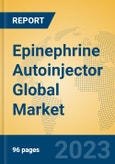Regional Market Trends
The epinephrine autoinjector market demonstrates stark regional disparities, with heavy concentration in developed economies due to stringent anaphylaxis protocols and allergy surveillance systems.- North America: Dominating with a CAGR of 3.0%-5.0%, this region's preeminence arises from FDA-mandated labeling and widespread school mandates. The United States, the overwhelming consumer, propels growth through EpiPen's entrenched role in peanut-allergic youth cohorts, where 2.5% of children carry prescriptions; trends emphasize over-the-counter expansions and trainer devices in suburban demographics, though rural access lags.
- Europe: Closely trailing at a CAGR of 2.5%-4.5%, EMA harmonization and national health services ensure broad coverage. The United Kingdom leads uptake via NHS free supplies for at-risk children, with Jext favored for its compact design in travel-heavy populations; Germany's statutory insurance prioritizes dual-chamber models amid rising birch pollen sensitivities.
- Asia-Pacific: Emerging with a CAGR of 4.0%-6.0%, urbanization and dietary westernization amplify needs, though penetration remains low. Japan stands out as the primary adopter, with MHLW subsidies for Anapen in shellfish-allergic adults; China's urban centers see gradual Auvi-Q imports, constrained by diagnostic underreporting.
- Latin America: Modest at a CAGR of 3.5%-5.0%, public health initiatives bridge gaps. Brazil emerges as the key market, where SUS stockpiles Adrenaclick for school emergencies in nut-sensitive favelas, trends toward affordable generics in coastal seafood hotspots.
- Middle East and Africa (MEA): Trailing with a CAGR of 2.0%-4.0%, aid programs and expatriate influences shape limited adoption. Saudi Arabia advances via SFDA approvals for Emerade in date palm allergy clusters, while South Africa's private clinics integrate Jext for urban elites, hampered by rural epinephrine deserts.
Application Analysis
The epinephrine autoinjector market segments by application, reflecting age-specific anaphylaxis risks and dosing nuances that guide device miniaturization and training protocols.- Children: This vital segment grows at a CAGR of 4.0%-6.0%, encompassing infants to adolescents where food-triggered reactions predominate, accounting for 70% of pediatric cases with onset often before age 5. Features include color-coded, low-volume 0.15mg cartridges and pictorial guides to ease parental anxiety, with trends toward app-linked trainers simulating injections for school preparedness; developments emphasize needle-shield enhancements to prevent accidental sticks, addressing 40% caregiver hesitation.
- Adult: Steady at a CAGR of 3.0%-5.0%, adults face medication and hymenoptera venom triggers in 60% of episodes, favoring 0.3mg standard doses with ergonomic grips for self-administration during commutes. Evolutions spotlight voice-prompted models like Auvi-Q for elderly users with dexterity issues, integrating GPS alerts for bystander aid; future vectors probe combination devices with antihistamines for biphasic mitigation.
Company Profiles
- Viatris: EpiPen Auto-Injectors generated USD 350-450 million in 2024 revenues, commanding U.S. market leadership through authorized generics and school contracts; Viatris's global scale, inherited from Pfizer's portfolio, bolsters supply resilience amid past shortages.
- Kaleo: Auvi-Q (epinephrine injection, USP) differentiates with audio instructions and compact form, carving a niche in pediatric prescriptions; Kaleo's patient access programs waive copays for uninsured families, enhancing loyalty in allergy hotspots.
- Amneal Pharmaceuticals: Adrenaclick (epinephrine) offers affordable generic alternatives, gaining traction in budget-constrained formularies; Amneal's U.S.-focused manufacturing ensures rapid restocking.
- Arrotex Pharmaceuticals: Anapen (epinephrine) prevails in Australia-centric markets with dual-dose options, emphasizing export synergies to Asia-Pacific.
- Medeca Pharma AB: Emerade (epinephrine) innovates with variable dosing (0.15/0.3mg) in one device, appealing to growth-spurt children; Medeca's European base supports EMA-compliant expansions.
- ALK-Abelló Ltd: Jext (epinephrine) sustains in allergy immunotherapy overlaps, with 2024 sales buoyed by U.K. school mandates; ALK's immunotherapy heritage integrates training kits.
Industry Value Chain Analysis
The epinephrine autoinjector value chain coordinates from synthetic catecholamine synthesis to emergency ecosystem deployments, optimizing for stability and rapid scalability. Upstream research and development harnesses HPLC analytics for 1:1000 epinephrine purity, with stability studies in amber glass mitigating oxidation; collaborations with allergy institutes refine human-factor engineering for thumb-grip ergonomics, costs averaging USD 50 million per iteration offset by FDA 510(k) clearances. Clinical validation employs simulation trials per ISO 11608, incorporating pharmacokinetic peaks at 5-10 minutes, with EMA's mutual recognition accelerating pediatric labels. Midstream manufacturing integrates sterile filling of 1ml cartridges in nitrogen-flushed lines, spring assembly via precision stamping yielding 99% activation rates; CMOs in Ireland scale 10 million units annually, generics via AB ratings slashing 40%. Formulation employs metabisulfite preservatives for 18-month viability, packaged in foil pouches with desiccant. Downstream distribution leverages just-in-time logistics to wholesalers like AmerisourceBergen, with school bulk buys via GPO tenders; direct-to-consumer via Amazon mitigates expirations through recycling programs. Marketing targets AAAAI congresses with demo booths and digital campaigns on EpiPen alternatives, HEOR via ICER models pegging $20,000 per life-year saved. Patient education includes carousel trainers and apps scanning lot numbers, pharmacovigilance via MedWatch for rare angioedema. Vertically aligned Viatris streamlines from API sourcing to claims analytics, fortifying against shortages like the 2023 recall.Opportunities and Challenges
Opportunities:
- Allergy Epidemic Responses: Rising pediatric food allergies (up 50% in 20 years) via school mandates unlock $200 million in volumes, smart injectors with NFC alerts amplifying 30% usage.
- Global Access Initiatives: WHO-backed stockpiles in APAC/LA offer penetration, generics halving $600 retail to $300.
- Device Innovations: Needle-free jets or wearable pods target phobia in 25% adults, pediatric mini-doses expanding.
- Biphasic Preparedness: Dual-pack standards per guidelines double prescriptions, combos with oral antihistamines.
Challenges:
- Supply Chain Fragilities: API dependencies on China risk 20% shortages, inflating prices 50% as in 2017.
- Expiration Wastes: 30% discarded annually burdens payers $100 million, demanding longer-shelf tech.
- Training Gaps: 40% misuse in simulations necessitates mandatory education, rural deserts delaying response.
- Cost Burdens: $600 biannual outlay deters 20% low-income, value-based rebates lagging.
This product will be delivered within 1-3 business days.
Table of Contents
Companies Mentioned
- Viatris
- kaleo
- Amneal Pharmaceuticals
- Arrotex Pharmaceuticals
- Medeca Pharma AB
- ALK-Abelló Ltd








